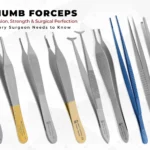Surgical instruments are at the heart of medical procedures, aiding doctors in diagnosing and treating patients effectively. Among these tools is the Van Buren sound, a specialized instrument essential in urological procedures. Designed with precision and functionality in mind, this instrument plays a pivotal role in medical diagnostics and treatments.
What Are Van Buren Sounds?
Van Buren sounds are specialized surgical instruments primarily used in the field of urology. Their primary purpose is to examine and treat conditions within the urethra. These instruments are long, slender, and slightly curved, making them ideal for navigating the male urethra’s natural anatomy. While primarily designed for use in male patients, they can also serve diagnostic applications in females under certain circumstances. Constructed from durable and sterilizable materials such as stainless steel, these instruments offer both precision and safety. Their design allows medical practitioners to identify abnormalities, obstructions, or narrow sections in the urethra, making them indispensable in diagnostic and procedural settings.
The Design and Features of Van Buren Sounds
The unique design of Van Buren sounds sets them apart from other surgical instruments used in urology. They typically feature a long, gently curved shaft that mirrors the anatomical structure of the male urethra. The curvature ensures minimal discomfort during insertion while providing ease of access to specific sections of the urethral canal. At the tip of the instrument is a rounded end, reducing the risk of tissue damage. This design choice ensures the instrument can be maneuvered delicately without causing harm. Van Buren sounds are often available in a variety of sizes, enabling medical professionals to select the most appropriate one based on the patient’s anatomy and the specific procedure being performed. Additionally, these instruments are manufactured to maintain exacting size standards, allowing for consistent outcomes in procedures. The ability to sterilize and reuse the instruments further enhances their utility in a clinical setting.
Purpose and Applications in Surgical Procedures
Van Buren sounds play a crucial role in a wide range of urological procedures. One of their primary applications is the diagnosis and management of urethral strictures. Urethral strictures occur when the urethral canal becomes narrowed, often due to scarring from infections, surgeries, or injury. The sound helps detect and measure the severity of these strictures, guiding subsequent treatments. Another significant use of Van Buren sounds is in the dilation of the urethra. This procedure involves gradually widening the urethral canal to treat blockages or strictures, allowing for improved urinary flow. The instrument’s size gradation is pivotal here, enabling doctors to increase the dilation incrementally and safely. These instruments are also utilized in catheterization procedures, ensuring the catheter can be accurately positioned within the bladder. Furthermore, Van Buren sounds play a diagnostic role in identifying certain conditions such as congenital abnormalities or the presence of foreign objects within the urethra.
Importance in Medical Practice
Van Buren sounds hold immense importance in medical practice due to their role in improving diagnosis and treatment outcomes in urology. By accurately detecting and addressing urethral abnormalities, they contribute significantly to patient care and comfort. Their capability to perform both diagnostic and therapeutic tasks makes them a versatile tool in modern urology. The medical community’s trust in these instruments stems from their reliability and effectiveness. They help reduce the incidence of invasive surgeries by enabling minimally invasive diagnostic and procedural options. This not only preserves the health of patients but also lowers the associated risks and recovery times. Furthermore, Van Buren sounds are a vital component of medical training. Aspiring urologists are frequently taught how to use these instruments safely and effectively as part of their education. By mastering the handling of Van Buren sounds, practitioners can enhance their ability to provide high-quality care to their patients.
Ensuring Safety and Best Practices in Use
While Van Buren sounds are designed for precision and safety, the proper handling of these instruments is essential. Medical professionals must be thoroughly trained in their use to minimize patient discomfort and reduce the risk of complications. Adequate sterilization practices are also critical to prevent infections and maintain patient safety. Doctors often use local anesthesia or lubrication to alleviate potential discomfort during procedures involving Van Buren sounds. These steps ensure patient comfort while preserving the instrument’s diagnostic effectiveness. By adhering to standard protocols, healthcare providers can ensure these instruments are employed safely and effectively.
Final Thoughts
Van Buren sounds are more than just tools of the trade in urological medicine—they represent a critical aspect of patient care and surgical precision. Their specialized design, combined with their effectiveness in both diagnosis and treatment, makes them an enduring and indispensable part of medical practice. With advancements in medical technology, the role of such tools continues to be integral, ensuring that patients receive the best possible care for urological conditions.












